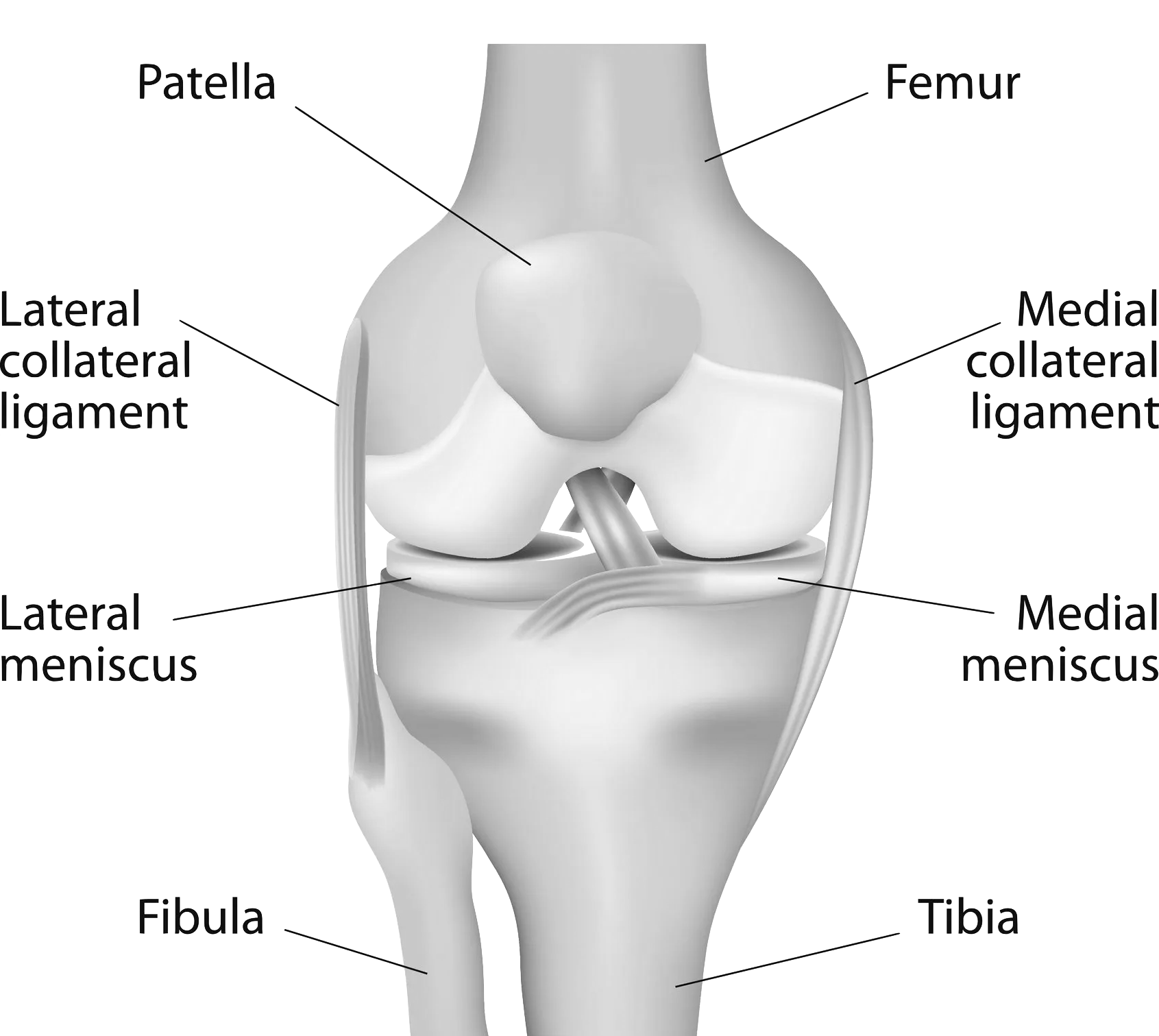Knee Meniscus Tears
What are Knee Meniscus Tears?
Knee meniscus tears, also known as torn cartilage or meniscal tears, occur when a tear or a rupture in the cartilage separates the thigh bone (femur) from the shinbone (tibia) in the knee joint.
This tear can cause the cartilage to break into pieces, which can cause pain, swelling, and discomfort.
How Does a Knee Meniscus Tear Impact Your Anatomy and Health?
The knee meniscus is a critical component of the knee joint, as it helps to absorb shock and distribute weight evenly across the joint.
When the meniscus tears, it can cause pain, swelling, stiffness, and decreased range of motion. Over time, untreated knee meniscus tears can lead to degenerative joint disease or arthritis.
Who is Most at Risk for Knee Meniscus Tear?
Knee meniscus tears can happen to anyone, but they are most common in athletes and older adults. Athletes who participate in sports that involve twisting, pivoting, or sudden stops, such as basketball, football, or soccer, are at a higher risk of developing a meniscus tear.
Older adults are more prone to degenerative meniscal tears due to age-related changes in the cartilage.
Causes of Knee Meniscus Tears
Knee meniscus tears can occur due to various reasons. The most common causes of knee meniscus tears include:
- Sudden twisting or pivoting movements: Athletes who participate in sports that involve these movements, such as basketball, soccer, and football, are at higher risk of developing a meniscal tear.
- Direct blow or impact to the knee joint: This can happen during a fall, a car accident, or a sports-related collision.
- Repetitive strain or overuse of the knee joint: This is common in people who engage in repetitive kneeling, squatting, or lifting.
- Degeneration of the meniscus due to aging: As you age, the meniscus can degenerate and become more prone to tears. This is because the cartilage becomes weaker and less flexible over time.
Other factors that may increase the risk of developing a meniscal tear include:
- obesity
- a previous knee injury
- certain occupations that require repetitive knee movements
It is essential to take preventative measures, such as warming up before exercise, using proper technique, and wearing appropriate protective gear, to reduce the risk of developing a meniscal tear.
Symptoms of Knee Meniscus Tears
The symptoms of a knee meniscus tear can vary depending on the severity and location of the tear. Some common symptoms include:
- pain, especially when twisting or bending the knee
- swelling within 24 hours
- stiffness in the knee joint
- difficulty walking for several days
- a popping or clicking sensation when moving the knee
- limited range of motion
- a feeling of instability in the knee joint
- tenderness along the joint line
- a tendency for the knee to get "stuck" or lock up
Types of Knee Meniscus Tears
There are different types of knee meniscus tears, depending on the location and severity of the tear. The three main types of meniscal tears are:
- Radial tears: Occur perpendicular to the meniscus's surface and are often located in the outer third of the meniscus. These types of tears may be caused by acute injuries or degenerative changes in the meniscus. Radial tears may cause the meniscus to become unstable and require surgical treatment.
- Horizontal tears: Occur parallel to the meniscus's surface and can be located in any part of the meniscus. These tears can cause a flap of cartilage to hang into the joint, leading to pain and discomfort. Horizontal tears may require surgical treatment, depending on the location and size of the tear.
- Complex tears: A combination of radial and horizontal tears and can be located in any part of the meniscus. These types of tears are often more challenging to treat and may require surgical intervention to repair or remove the damaged tissue.
In addition to the three main types of meniscal tears, other less common types of tears include:
- Oblique tears: Occur at an angle to the meniscus's surface and can be located in any part of the meniscus. These types of tears may cause the meniscus to become unstable and may require surgical treatment.
- Bucket handle tears: A severe type of meniscal tear that occurs when a large portion of the meniscus is torn away from the rest of the tissue. This type of tear can cause the meniscus to become displaced and may require immediate surgical intervention.
Stages of Knee Meniscus Tears
- Stage 1: Considered mild and involves small tears on the meniscus surface. These tears typically do not cause significant pain or discomfort and may not require surgery. Treatment for stage 1 meniscal tears may include rest, physical therapy, and anti-inflammatory medications.
- Stage 2: Considered moderate and involve partial tears that cause the meniscus to become displaced or move out of place. These tears can cause pain, swelling, and discomfort and may require surgical treatment. Treatment for stage 2 meniscal tears may include rest, physical therapy, anti-inflammatory medications, and possibly surgery to repair or remove the damaged tissue.
- Stage 3: Considered severe and involves complete tears that cause the meniscus to become displaced or move out of place. These tears can cause significant pain, swelling, and discomfort and may require immediate surgical intervention. Treatment for stage 3 meniscal tears typically involves surgery to repair or remove the damaged tissue, followed by rest, physical therapy, and anti-inflammatory medications to aid recovery.
Knee Meniscal Tears Diagnosis
To diagnose a knee meniscus tear, an orthopaedic surgeon will perform a physical examination and may order imaging tests, such as X-rays, MRI, or ultrasound.
The surgeon will check for tenderness, swelling, and knee joint range of motion during the physical examination. They may also perform specific maneuvers like the McMurray test to detect a meniscal tear.
Imaging tests can provide a more detailed view of the meniscus and help the surgeon determine the location and severity of the tear.
Diagnostic Imaging
- X-rays do not show cartilage but are often taken as they can help rule out other problems with the knee that may have similar symptoms like fractures (broken bone) or anterior cruciate ligament (ACL) injury.
- MRI can create detailed images of your knee's hard and soft tissues. An MRI can produce cross-sectional images of internal structures required if the diagnosis is unclear or other soft tissue injuries are suspected, such as ligament or articular cartilage injuries.
While not all of these tests are required to confirm the diagnosis, this diagnostic process will allow your doctor to review any possible risks or existing conditions that could interfere with the surgery or its outcome.
Knee Meniscus Tears Treatment
The treatment of knee meniscus tears depends on the severity, location, and type of tear. Treatment options include:
- Conservative treatment: For minor meniscus tears, conservative treatment options, such as rest, ice, compression, elevation (RICE) and physical therapy, may be recommended. Physical therapy can help to strengthen the surrounding muscles and improve the stability and flexibility of the knee joint.
- Medications: Pain relievers, such as nonsteroidal anti-inflammatory drugs (NSAIDs), can help to reduce pain and inflammation associated with meniscal tears.
- Injections: Corticosteroid injections can reduce pain and inflammation in the knee joint.
Meniscal Surgery
For severe or complex meniscal tears, surgery may be required. Surgery is advocated for active patients under 25 years old, especially if the tear is “fresh”, repairable and associated with an ACL injury. The type of surgery depends on the location and severity of the tear.
Surgery is recommended where patients endure ongoing episodes of:
- Pain
- Instability
- Swelling
- Locking
Surgery may be required if a patient wishes to restore function and stability and return to:
- Sports involving cutting or pivoting movements (e.g. soccer, football and netball)
- Physical jobs involving cutting or pivoting movements (e.g. policeman, fireman, builders, etc.)
Arthroscopic surgery, a minimally invasive procedure, is the most common surgical option for meniscal tears. The surgeon uses a small camera and surgical instruments to repair or remove the damaged meniscus during this procedure.
While not everyone requires surgery, meniscal tears do not heal without surgery.
What if Knee Meniscus Tears are Untreated?
If left untreated, knee meniscus tears can lead to chronic pain, stiffness, and weakness in the knee joint. Over time, untreated tears can also cause degenerative joint disease or arthritis, which can be debilitating.
It is essential to seek medical attention if you experience any symptoms of a meniscal tear, as early diagnosis and treatment can prevent further damage to the knee joint.



